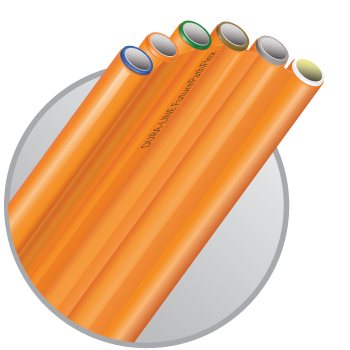MicroTechnology
MicroTechnology is a term given to smaller conduits and fiber used in Inside and Outside Plant Construction (ISP and OSP). MicroDucts were developed as a solution to house fiber cables that were smaller in size, but still carried significant capacity. Today, MicroCables range from 6 to 432-fiber counts. The glass fibers are the same type as those used in traditional fiber cables, only the cable design has been altered to reduce the diameter of the cable sheath and support system. MicroDucts bundled under one sheath are called FuturePath and provide multiple ducts in one structure for future expansion of networks.
FuturePath
Dura-Line FuturePathTM consists of multiple variations of MicroDuct in specific sizes bound together with an oversheath for ease of placement. All of the MicroDucts have internal longitudinal ribbing (1) and a permanent super-slick lining of Silicore™ to reduce friction during cable placement.
FuturePath can be placed as a cable pathway which will allow the Network to grow as needed, while placing only the cable required for immediate needs. Using reduced diameter Fiber Optic Cable (MicroCable), FuturePath can accommodate up to 432 fibers in each MicroDuct, depending upon the configuration chosen and the Fiber Cable Manufacturer’s design.
FuturePath is available with ripcord access and can be ordered in a locatable version for direct bury applications. It can be pulled into existing conduit, plowed in, trenched, or Horizontally Directional Drilled (HDD) without the need for any special tools or equipment. FuturePath can be manufactured from OSP HDPE, or inside Riser, Plenum, or LSHF (Low Smoke, Halogen Free) materials.
(1) All MicroDuct 8mm OD and larger.
FuturePath Flex
An array of MicroDucts connected by an oversheath and a tangential partitioned web. Its flat configuration and ease of duct segregation make it ideal for MicroTrenching and FTTX applications.
Duct separation is easily performed with nearly any knife, and it is available in Fire-Retardant versions for use inside buildings. The inside versions can be easily connected to the OSP FuturePath Flex by using push-on air and watertight couplers eliminating the need for a splice cabinet.
In this manner, a single, uninterrupted pathway is created for the fiber cable. The 18/14mm version is large enough to accommodate a pre-connectorized fiber drop with an SC-style connector and nylon pulling-sock, should that be the application requirements



